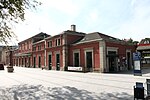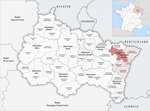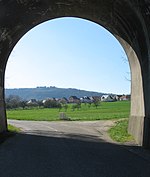Notre-Dame-de-la-Nativité (Saverne)

Notre-Dame-de-la-Nativité is the main church in Saverne, Bas-Rhin, France. It was first built in the 12th century as a parish church before being re-consecrated to saint Bartholomew in the late 13th century. It was converted into a collegiate church of Augustinian Canons Regular in the 14th and 15th century and held that status by 1485 at the latest. It is now the town's parish church and has been listed a historic monument since 1977. The oldest items of church furniture are the 1495 pulpit (with stone marks by Hans Hammer, master mason at Strasbourg Cathedral) and a carved wooden sculpture of the Virgin and Child from the same era, probably by Nikolaus Hagenauer. The choir has a 16th-century crucifix, a 15th-century pieta and part of a limewood sculpture of the Assumption, probably from a 1486 altarpiece. The windows in the main nave were almost completely destroyed by a bombing raid on the night of 30–31 July 1918.
Excerpt from the Wikipedia article Notre-Dame-de-la-Nativité (Saverne) (License: CC BY-SA 3.0, Authors, Images).Notre-Dame-de-la-Nativité (Saverne)
Place de l'Église, Saverne
Geographical coordinates (GPS) Address External links Nearby Places Show on map
Geographical coordinates (GPS)
| Latitude | Longitude |
|---|---|
| N 48.7412 ° | E 7.364 ° |
Address
Église Notre-Dame-de-la-Nativité
Place de l'Église
67700 Saverne
Grand Est, France
Open on Google Maps








